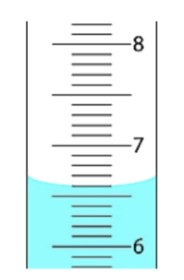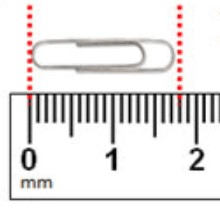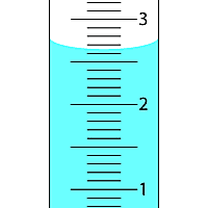What is the term for:
The amount of matter in an object
Mass
Qualitative or Quantitative:
COAT(S) describes what kind of observation?
Qualitative
Example: Mr. Doyle is wearing a blue shirt and has no hair
What is an Independent Variable? How many are there in an experiment?
The thing I change in an experiment, and there is only 1 independent variable in an experiment
A metal cube has a mass of 240 grams (g) and occupies a volume of 80 cubic centimeters (cm3).
What is the density of the metal cube? (use the 3 step method in your answer)
Density = 3 g/cm3
1. D = M/V
2. D = 240 g / 80 cm3
3. D = 3 g/cm3
What length of the chocolate bar in centimeters?
20 cm
What is the term for:
The amount of space an object takes up
Volume
Qualitative or Quantitative:
Data that is measured with either mass, volume, weight, and/or density.
Quantitative
Example: Mr. Doyle is 1.9 meters tall and has a mass of 90 kilograms
What is the dependent variable?
The data that is collected based on the independent variable changing.
A fish tank is filled with maple syrup that has a volume of 50 liters (L). If the density of the maple syrup is 1.3 kilograms per liter (kg/L).
What is the total mass of the syrup in the tank? (use the 3 step method in your answer)
Mass = 65kg
D = M/V,
1. M = D(V)
2. M = 50 L / 1.3 kg/L
3. M = 65 kg
What is the volume of of the liquid in milliliters?
6.6 mL
What is the term for:
Anything that has mass and takes up space
Matter
A hypothesis is best written in what format?
If...then...because
Example: If Mr. Doyle eats ice cream before bed, then he will not sleep will because Mr. Doyle is lactose intolerant
What are controlled variables?
Controlled variables are variables that stay the same during an experiment.
Samantha has a paper bag that weighs 200 grams (g). The density of the paper is 0.4 grams per cubic centimeter (g/cm3).
What is the volume of the paper bag in cubic centimeters? (use the 3 step method in your answer)
Volume = 500 cm3
D = M/V
1. V = M/D
2. V = 200 g / 0.4 g/cm3
3. V = 500 cm3
What is the length of the paperclip in centimeters
1.8 cm
The pull of gravity on matter
Weight
Qualitative of Quantitative:
The burp is a sudden, loud expulsion of air that resonates with a bubbly, gurgling sound. It has a surprising, almost comedic quality, often leaving a faint, tangy scent in the air. Its abruptness can catch listeners off guard, eliciting laughter or playful reactions.
Qualitative
It describes the sound and odor.
How many qualitative observations and quantitative observations are listed:
In the experiment testing how different liquids affect plant growth, water proved to be the best choice. Watered plants were vibrant green and grew an average height of 25 centimeters, while soda-treated plants had brown edges and reached only 15 centimeters. Juice-treated plants attracted more insects and grew to 20 centimeters. The plants were measured every 3 days, for 21 days.
3 Qualitative Observations
4 Quantitative Observations
A watermelon has a mass of 9 kilograms (kg) and a density of 1.2 kilograms per liter (kg/L).
If you cut the watermelon into equal halves, how much volume would each half be?
show your work!
Volume = 3.75 L
D= M/V
1. V = (M/D) / 2
2. V = (9 kg / 1.2 kg/L) / 2
3. V = 3.75 L
What is the length of the red bar in millimeters?
140 mm
What is the difference between an observation and an inference?
An observation describes information that we gather with our senses while an inference describes what we think we know based on that information.
Example: The can is shiny and silver, so I think it is made of metal.
How many qualitative and quantitative observations are made in the following statement:
The burp produces a loud, guttural noise measuring around 80 decibels and lasts approximately two seconds, with a scent resembling a mix of carbonated soda and spicy food; it occurs about once every 5 to 10 minutes after eating, expels air at body temperature (37°C), and releases roughly 50 milliliters of gas.
Qualitative Descriptions: 2
- Sound
- Odor
Quantitative Descriptions: 5
- Sound Volume:
- Duration:
- Frequency:
- Temperature:
- Gas Volume:
A group of IMS students want to conduct an experiment that tests different brand sodas and their affects on the rate of decay on eggshells to simulate tooth decay.
List 4 controlled variables that the students should be mindful of
(1) Type of eggshells
(2) the amount (mass) of the initial eggshells
(3) the amount (volume) of soda used
(4) the temperature of the soda
(5) the temperature of the room
(6) the amount of time the eggshells are exposed to the soda
A sample of magma has a mass of 2,400 grams (g) and occupies a volume of 1,500 cubic centimeters (cm3). When the magma cools and solidifies into an igneous rock, its mass increases by 12.5% and its volume decreases by 20%
What is the density of the igneous rock?
Show your work!
Density = 2.25g/cm3
2,400 g (1.125) = 2,700g
1,500 cm3 (0.8) = 1,200 cm3
1. D = M/V
2. D = 2,700 g / 1,200 cm3
3. D = 2.25 g/cm3
What is the volume of the liquid in milliliters?
2.65 mL